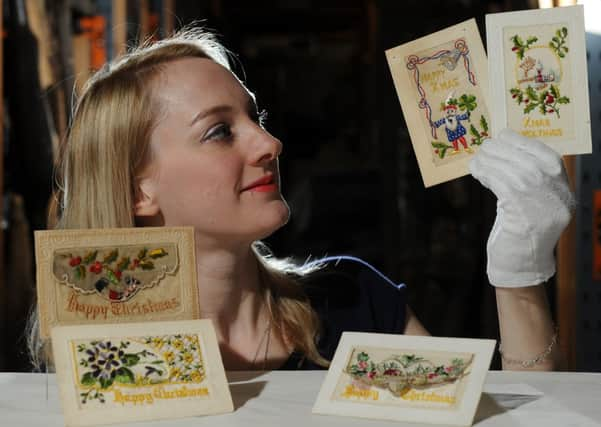The exquisite silk Christmas cards from WW1 trenches


The cards, sent by soldiers to loved ones, often contained moving and personal messages and were a source of great comfort for those families separated by the conflict and unable to spend the holiday season together.
Staff at York Castle Museum yesterday revealed some of the hand made Christmas cards sent from First World War soldiers to loved ones back home it has in its collections. The embroidered cards, known as WWI Silks, were made as souvenirs to be sold to soldiers.
Advertisement
Hide AdAdvertisement
Hide AdThe embroidery was generally carried out by French or Belgian women working either in their own homes or in refugee camps.
Many of the cards include personal messages to family back home.
The cards are being catalogued by the museum in preparation for a major exhibition 1914: When the World Changed Forever, which opens on June 28 next year.
Faye Prior, collections facilitator at York Castle Museum, said yesterday: “We have many of these hand embroidered cards in our collection and each one offers us a very personal and often moving message from soldiers wishing their family a Merry Christmas.
Advertisement
Hide AdAdvertisement
Hide Ad“Thousands of cards similar to these were hand made by women to sell to troops and many show scenes we do not necessarily associate with Christmas today, such as swallows, flowers and boats. It was only later that the trend towards winter scenes, Christmas trees and Father Christmas began to dominate Christmas cards like they do today,” Dr Prior added.
The use of embroidery in cards was most popular with British and American servicemen and the designs in the museum’s collection reflect this. The women who created them worked the embroidery to create strips that could be used on up to 25 cards, then sent the finished strips to factories where they would be cut and mounted, ready to be sold.
Museum staff say embroidery does show up on earlier cards, for example on Victorian greetings cards, but it is not known exactly when the tradition started.
The cards in the collection are not dated so it is not known which year of the conflict they came from.
Advertisement
Hide AdAdvertisement
Hide AdMuseum bosses say that the cards were not cheap but would have been within the reach of a regular Tommy with a few shillings to spare.
A spokesman for the museum said yesterday: “How long it took for the cards to get home entirely depended on where the soldier was stationed, and what stage of the war, as well as the regular issues with any postal service. Most letters and cards had to go through a military censor, which would delay them.
“Judging by letters in our collection people were used to getting their post within days of it being sent, but this wasn’t always the norm.
“These cards aren’t rare, but they’re very delicate. It’s very hard to judge how many were sent at the time, but numbers are likely to be in the thousands each year,” the spokesman added.
Advertisement
Hide AdAdvertisement
Hide AdEarlier this year it was revealed that a major exhibition on the First World War is set to take place at the museum after it secured £1.7m from Lottery bosses.
The grant from the Heritage Lottery Fund will provide the majority of cash for the project, designed to mark the centenary of the war, and will take place in large new exhibition spaces on the first floor, with all office space moving to the second floor.
The new exhibition 1914: When the World Changed Forever will look at the terror of total war and its revolutionary impact on life around the world.
New technology and research will be combined with the museum’s extensive military, costume and social history collections to tell the fascinating and often moving stories of the Yorkshire people who lived and died during the war that they said would end all wars.